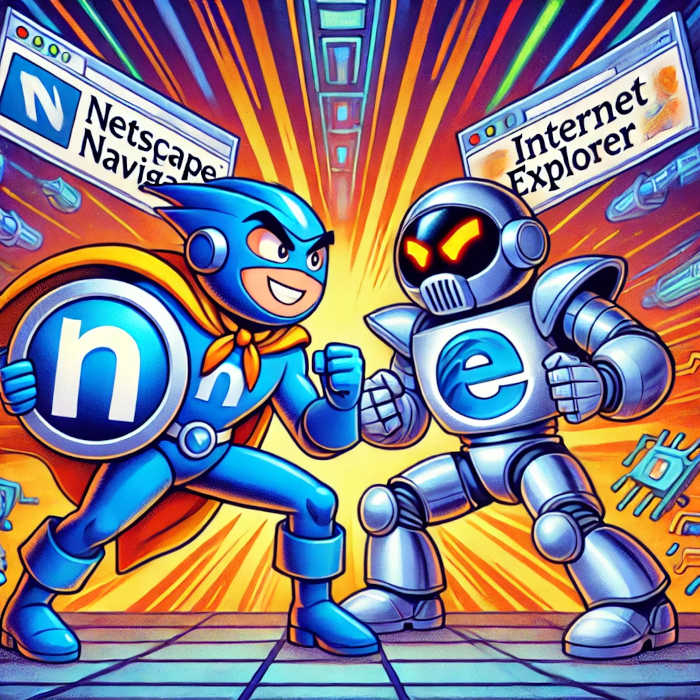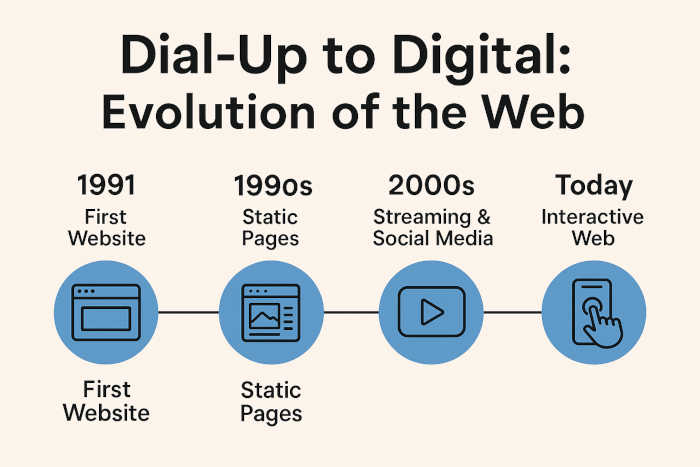As an Amazon Associate, I earn from qualifying purchases. Privacy Policy / Terms
The internet—where memes go viral, cat videos never end, and “googling” is second nature. But have you ever stopped mid-scroll and thought, “How did all this chaos even start?” Let’s rewind the clock and dive into the humble beginnings of the World Wide Web, where static pages ruled and waiting for an image to load felt like an eternity. From those clunky, text-heavy origins to the sleek, lightning-fast website experience we can’t live without today, it’s a wild ride worth revisiting.
The Humble Beginnings: CERN’s Digital Baby
Picture this: It’s 1989, and while the world is busy teasing their hair and rocking out to Madonna, a British scientist named Tim Berners-Lee is cooking up something revolutionary at CERN, the European Organization for Nuclear Research. His mission? To create a system that allows scientists to share information seamlessly. The result? The World Wide Web.
Fast forward to August 6, 1991. Without much fanfare, Berners-Lee launches the first-ever website. And what was this groundbreaking site’s purpose? A meta masterpiece—it was a site about the World Wide Web project itself, detailing how to create web pages and explaining the concept of hypertext. You can still visit this relic in all its glory at http://info.cern.ch.
The Web’s Awkward Teenage Years: Text-Only to Table Mania
In the early ’90s, the web was like a teenager going through an identity crisis. The first websites were text-only affairs, resembling digital encyclopedias more than the vibrant, interactive spaces we know today. Images? Forget about it. It was all about that ASCII life.
But as with all teenagers, change was inevitable. Enter the mid-1990s, and suddenly, websites got a glow-up. Thanks to the introduction of tables in HTML, designers could finally play around with layouts. This era saw the birth of multi-column designs, sidebars, and, let’s not forget, those oh-so-trendy tiled background images. It was a time when more was more, and subtlety was left at the door.
The Browser Wars: Netscape vs. Internet Explorer
No history of the web is complete without mentioning the epic showdown between Netscape Navigator and Internet Explorer. Think of it as the digital equivalent of the cola wars—Coke vs. Pepsi, but with more coding and less sugar.
Netscape Navigator burst onto the scene in the mid-’90s, quickly becoming the browser du jour. But Microsoft wasn’t about to let that slide. They introduced Internet Explorer, bundled it with Windows, and thus began the infamous “browser wars.” This fierce competition led to rapid advancements in web technologies but also a fair share of headaches for developers trying to make sites compatible across platforms.

Enter the Millennium: Flash and the Rise of Interactivity
As we partied like it was 1999 and stepped into the new millennium, the web decided to put on its dancing shoes. Adobe Flash became the life of the digital party, allowing for animations, interactive content, and those addictive mini-games that consumed hours of our lives. Websites transformed from static pages to dynamic experiences, complete with splash screens and, occasionally, questionable background music choices.
The Social Media Explosion: Connecting the World
Then came the era that turned us all into content creators—the rise of social media. Platforms like MySpace (yes, with your top 8 friends), Facebook, Twitter, and Instagram changed the way we interacted online. Websites were no longer just digital brochures; they became spaces for community, self-expression, and the occasional viral dance challenge. The web had evolved into a social butterfly, fluttering its wings across the globe.
Mobile Mania: The Web in Our Pockets
Remember when accessing the internet meant being tethered to a bulky desktop computer? Those days are as outdated as floppy disks. The advent of smartphones brought the web to our fingertips, anytime, anywhere. This shift forced designers to rethink their strategies, giving birth to responsive design—a fancy term for making sure websites look good on screens of all sizes. Pinch-to-zoom became a thing of the past as sites adapted to our mobile lifestyles.
The Modern Web: Sleek, Fast, and Personalized
Today, the web is a far cry from its humble beginnings. Modern websites designs are sleek, lightning-fast load times, and personalized content that eerily knows what you want before you do. Thanks to advancements in artificial intelligence and machine learning, the web experience is more tailored than ever. Whether it’s a streaming service recommending your next binge or an online store suggesting products, the web has become a digital concierge catering to our every whim.
Looking Ahead: The Future of the Web
So, what’s next on this wild web ride? As technology continues to evolve, we can expect even more immersive experiences. Virtual reality (VR) and augmented reality (AR) are poised to blur the lines between the digital and physical worlds. The concept of the “metaverse” is gaining traction, promising interconnected virtual spaces where we can work, play, and socialize. The web’s journey is far from over; in fact, it feels like we’re just getting started.
Conclusion: From One Page to a World Wide Wonderland
Reflecting on the web’s evolution is like flipping through a digital yearbook filled with memories of pixelated images, dial-up tones, and the thrill of discovering a new site. From that first humble page at CERN to the sprawling digital universe we navigate today, the web has come a long way. It’s been an exhilarating journey of innovation, creativity, and the occasional misstep (looking at you, auto-playing MIDI music).
As we stand on the precipice of new technological frontiers, one thing remains certain—the web will continue to evolve, surprise, and connect us in ways we have yet to imagine. So here’s to the World Wide Web: our digital playground, marketplace, and global community rolled into one. Cheers to the past, present, and the boundless future ahead!
Views Expressed Disclaimer
The views, opinions, and information presented in this article are for informational purposes only and do not necessarily reflect the official policies or positions of Cleveland Computer Guy. While every effort has been made to ensure accuracy, Cleveland Computer Guy is not liable for any errors, omissions, or decisions made based on the content provided. Readers are encouraged to consult professionals for specific advice or assistance related to their unique circumstances.







